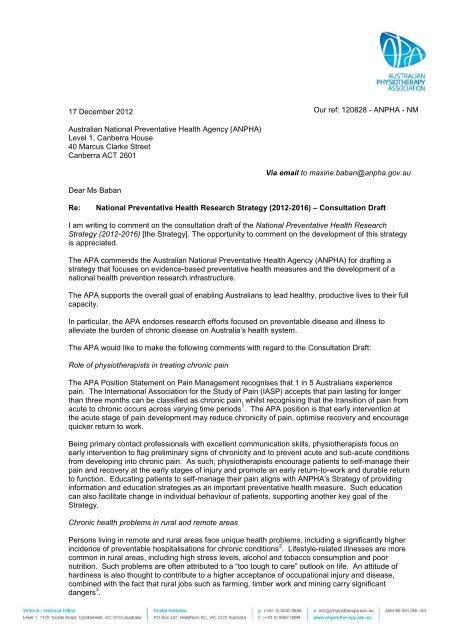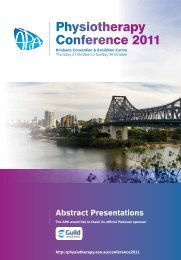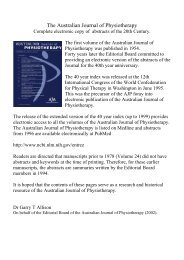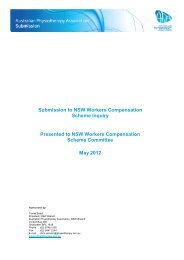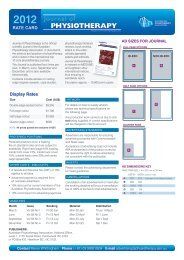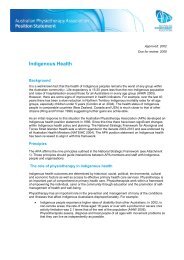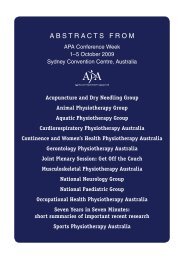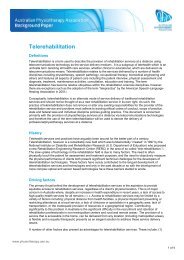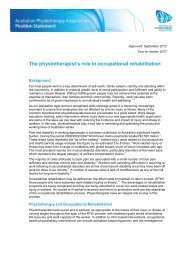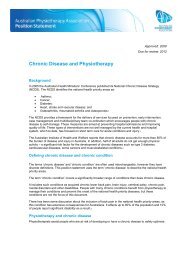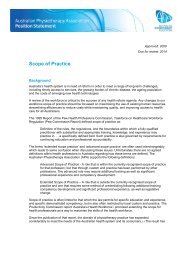Our ref: 120828 - ANPHA - Australian Physiotherapy Association
Our ref: 120828 - ANPHA - Australian Physiotherapy Association
Our ref: 120828 - ANPHA - Australian Physiotherapy Association
You also want an ePaper? Increase the reach of your titles
YUMPU automatically turns print PDFs into web optimized ePapers that Google loves.
17 December 2012<br />
<strong>Australian</strong> National Preventative Health Agency (<strong>ANPHA</strong>)<br />
Level 1, Canberra House<br />
40 Marcus Clarke Street<br />
Canberra ACT 2601<br />
<strong>Our</strong> <strong>ref</strong>: <strong>120828</strong> - <strong>ANPHA</strong> - NM<br />
LETTER RE NATIONAL<br />
PREVENTATIVE HEALTH<br />
RESEARCH<br />
STRATEGY.DOCX<br />
Via email to maxine.baban@anpha.gov.au<br />
Dear Ms Baban<br />
Re:<br />
National Preventative Health Research Strategy (2012-2016) – Consultation Draft<br />
I am writing to comment on the consultation draft of the National Preventative Health Research<br />
Strategy (2012-2016) [the Strategy]. The opportunity to comment on the development of this strategy<br />
is appreciated.<br />
The APA commends the <strong>Australian</strong> National Preventative Health Agency (<strong>ANPHA</strong>) for drafting a<br />
strategy that focuses on evidence-based preventative health measures and the development of a<br />
national health prevention research infrastructure.<br />
The APA supports the overall goal of enabling <strong>Australian</strong>s to lead healthy, productive lives to their full<br />
capacity.<br />
In particular, the APA endorses research efforts focused on preventable disease and illness to<br />
alleviate the burden of chronic disease on Australia’s health system.<br />
The APA would like to make the following comments with regard to the Consultation Draft:<br />
Role of physiotherapists in treating chronic pain<br />
The APA Position Statement on Pain Management recognises that 1 in 5 <strong>Australian</strong>s experience<br />
pain. The International <strong>Association</strong> for the Study of Pain (IASP) accepts that pain lasting for longer<br />
than three months can be classified as chronic pain, whilst recognising that the transition of pain from<br />
acute to chronic occurs across varying time periods 1 . The APA position is that early intervention at<br />
the acute stage of pain development may reduce chronicity of pain, optimise recovery and encourage<br />
quicker return to work.<br />
Being primary contact professionals with excellent communication skills, physiotherapists focus on<br />
early intervention to flag preliminary signs of chronicity and to prevent acute and sub-acute conditions<br />
from developing into chronic pain. As such, physiotherapists encourage patients to self-manage their<br />
pain and recovery at the early stages of injury and promote an early return-to-work and durable return<br />
to function. Educating patients to self-manage their pain aligns with <strong>ANPHA</strong>’s Strategy of providing<br />
information and education strategies as an important preventative health measure. Such education<br />
can also facilitate change in individual behaviour of patients, supporting another key goal of the<br />
Strategy.<br />
Chronic health problems in rural and remote areas<br />
Persons living in remote and rural areas face unique health problems, including a significantly higher<br />
incidence of preventable hospitalisations for chronic conditions 2 . Lifestyle-related illnesses are more<br />
common in rural areas, including high stress levels, alcohol and tobacco consumption and poor<br />
nutrition. Such problems are often attributed to a “too tough to care” outlook on life. An attitude of<br />
hardiness is also thought to contribute to a higher acceptance of occupational injury and disease,<br />
combined with the fact that rural jobs such as farming, timber work and mining carry significant<br />
dangers 3 .
Indigenous <strong>Australian</strong>s and chronic disease<br />
Hospitalisation rates for indigenous people are significantly higher than for non-indigenous<br />
<strong>Australian</strong>s. Indigenous <strong>Australian</strong>s are being admitted to hospital for treatment of chronic diseases<br />
such as diabetes which could, and should, be treated within a primary health care setting. A central<br />
problem contributing to continued ill health is that Aboriginals have lower levels of access to the MBS<br />
and PBS programs because of a shortage in GPs and other health workers in rural and remote<br />
areas 4 . The under-representation of indigenous health workers is a significant problem and further to<br />
this, non-indigenous health workers practicing in remote or rural areas often have limited training in<br />
the provision of culturally appropriate health services.<br />
Importance of workplace in enhancing healthy living<br />
The APA endorses <strong>ANPHA</strong>’s recognition that environments and settings such as in cities, workplaces<br />
and schools enhance healthy living. Physiotherapists support the provision of health and physical<br />
education in a school context and the APA upholds that regular physical activity in schools can foster<br />
a lifelong understanding of the health benefits of physical activity. Physiotherapists provide<br />
information and support to family, healthcare providers and the workforce. In the context of work<br />
specifically, physiotherapists assist employers to devise a safe system of work and educate injured<br />
workers on strategies to manage their injury, so they can return to modified or full duties as soon as<br />
possible. Such practices align with <strong>ANPHA</strong>’s Strategy to improve practices supportive of removing or<br />
reducing risks.<br />
The APA believes that early intervention should be provided in the context of an effective workplacebased<br />
rehabilitation program.<br />
Work is very important to an individual’s health and well-being overall. Without fulfilling work, people<br />
may not achieve their potential at the expense of themselves, their families and their communities,<br />
and work is of great importance to an individual’s health and wellbeing 5,6 .<br />
It is important that physical interventions provided by physiotherapists in the clinical setting are then<br />
able to be transferred to the workplace. For example, the practice of lifting a box in a clinic is<br />
designed to ensure the injured worker is able to have the physical capability and confidence to lift a<br />
box in the same manner at the workplace.<br />
By assessing the physical requirements of the workplace early in the recovery process,<br />
physiotherapists can design specific interventions that have a direct impact on the return to work<br />
process and the physical capability of the worker. As such, the early undertaking of a workplace<br />
assessment by physiotherapists (or appropriate other provider) is crucial to enable the design of<br />
appropriate interventions that maximise early and durable return to work.<br />
Once again, thank you for the opportunity to comment on the Consultation Draft. The APA would be<br />
pleased to remain engaged in any further developments and would welcome future consultations on<br />
chronic disease risk factors and national research priorities.<br />
Should you have any enquiries, feel free to contact Jonathon Kruger, General Manager, Advocacy<br />
and International Relations Division, at jonathon.kruger@physiotherapy.asn.au.<br />
Yours faithfully<br />
Melissa Locke<br />
President
1. <strong>Australian</strong> <strong>Physiotherapy</strong> <strong>Association</strong>. (2012). Position Statement on Pain Management. APA,<br />
Victoria. Available at<br />
http://www.physiotherapy.asn.au/images/Document_Library/Position_Statements/2016%20-<br />
%20pain%20management.pdf<br />
2. <strong>Australian</strong> Institute of Health and Welfare. (2010). Australia’s Health 2010. Australia’s Health<br />
Series no.12.Cat.no. AUS 122. Canberra: AIHW<br />
3. <strong>Australian</strong> Rural Health Research Institute. (1995). Dabbling With Data: Morbidity and<br />
Mortality in Rural Australia Part 1. Available at<br />
http://nrha.ruralhealth.org.au/conferences/docs/PAPERS/3_ROGSTR.pdf<br />
4. Rural Health Workforce Australia. (2007). Indigenous health workforce policy: a background<br />
paper. Available at http://www.rhwa.org.au/client_images/528383.pdf<br />
5. Black D. C. (2008). Working for a healthier tomorrow: Dame Carol Black's review of the<br />
health of Britain's working age population. Norwich: The Stationery Office.<br />
6. Aylward, M. (2010). Realising the Health Benefits of Work. Australasian Faculty of<br />
Occupational & Environmental Medicine Position Statement. Available at<br />
http://www.racp.edu.au/page/policy-and-advocacy/occupational-and-environmental-medicine


